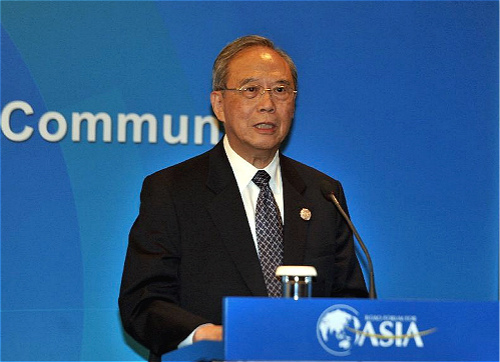Zeng Peiyan: “One belt and one road” brings opportunities to the building of the East Asia Economic Community
- Time:2015-03-28
- source:CCIEE
Time:2015-04-25 09:13:56 Views:115265 Origin:Boao Forum for Asia

“China has always been dedicated to achieving win-win cooperation with the neighboring countries and seeking joint development with them. Its ‘one belt and one road’ strategy brings significant opportunities to the realization of the East Asia Economic Community.”
At BFA’s “Building the East Asia Economic Community” sub-forum held on March 28, Zeng Peiyan, BFA vice chairman and former vice premier of China, gave a speech and presented five suggestions on the building of the East Asia Economic Community (EAEC). He also held that the “10+3” mechanism had the potential to become the main channel for promoting the integration of East Asia.
“In recent years, the economic center of gravity has been inclining to East Asia. The world has seen the formation of three over-18-trillion-USD economic communities, which include East Asia, EU, and North America. By the end of last year, the East Asia, which covers the Greater China region across the Taiwan Straits, Japan, South Korea, and ASEAN, had a total GDP accounting for 24.5% of the world total, exceeding that of EU and slightly lower than that of North America. In international trade volume, East Asia has a contribution rate higher than that of EU and North America. In 2013, the goods import and export volume of East Asia took up 27.8% of the world total, higher than the 17.5% of EU and nearly doubling that of North America.
According to Zeng Peiyan, because of historical and other reasons, the cooperation among the economies in East Asia still remains at a relatively lower stage and their economic integration lags far behind other economies. Building a more influential East Asia Economic Community has become an urgent strategy facing all of them.
“The orientation of EAEC should be an all-inclusive institutional arrangement covering all sectors, including trade, investment, finance, infrastructure, and industry. EAEC should maintain inclusiveness and fairness and view all economies, big or small, as equal,” Zeng Peiyan presented five personal suggestions on the building of EAEC.
First, it is suggested that the current various bilateral and multilateral relations be integrated. East Asia represents a quarter of the world’s economic aggregate and houses a third of world population. It has huge market opportunities. However, its economies keep numerous bilateral and multilateral relations among themselves, which are overlapping, uncoordinated, and subject to different rules, and thus prevent a unified market standard.
Second, it is suggested that a logistic system covering the entire East Asia be built up. Such system is an important supporter to economic integration in the region. It should have interconnected infrastructure to guarantee smooth logistics.
In addition, Zeng Peiyan specifically mentioned that the internet of things should be technically merged with the internet to form a more efficient internet and more convenient e-commerce in EAEC.
Third, it is suggested that the soft environment of the market be optimized and stress be laid on the construction of such soft environment elements as rules, policies, supervision, and standard. Fourth, it is suggested that a trans-regional financial system be constructed. Fifth, it is suggested that cooperation be adopted to cope with the external problems of the economy, including climate change, environmental pollution, and sustainable development of energy and water.
“China has always been dedicated to achieving win-win cooperation with the neighboring countries and seeking joint development with them; its ‘one belt and one road’ strategy brings significant opportunities to the realization of the East Asia Economic Community,” Zeng Peiyan specifically pointed out.
EAEC has long been a common goal for East Asia countries. In answering the question, “what is the mechanism to promote the building of EAEC?” Zeng Peiyan pointed out that the “10+3” mechanism may become the main channel for promoting the integration of East Asia.
“In 2014, leaders of ‘10+3’ already agreed to upgrading it into an international organization. Therefore, I figure that in the process of promoting EAEC, we should make use of the current ‘10+3’ mechanism to increase the cooperation in economic trade, investment, and finance, enlarge operation scope, and put forward the structure of EAEC and the political proposals. This should be handled by a specific department. I hope my suggestion can receive active response from ‘10+3’,” Zeng Peiyan answered.
Zeng Peiyan said that in fact, the proposal of EAEC was once put on the agenda. At the Summit for the 15th Anniversary of the Cooperation among ASEAN, China, Japan, and South Korea held in Cambodia in 2012, leaders of these countries passed the report by the East Asia Prospect Group and clearly set the goal --- building up EAEC by 2020.
